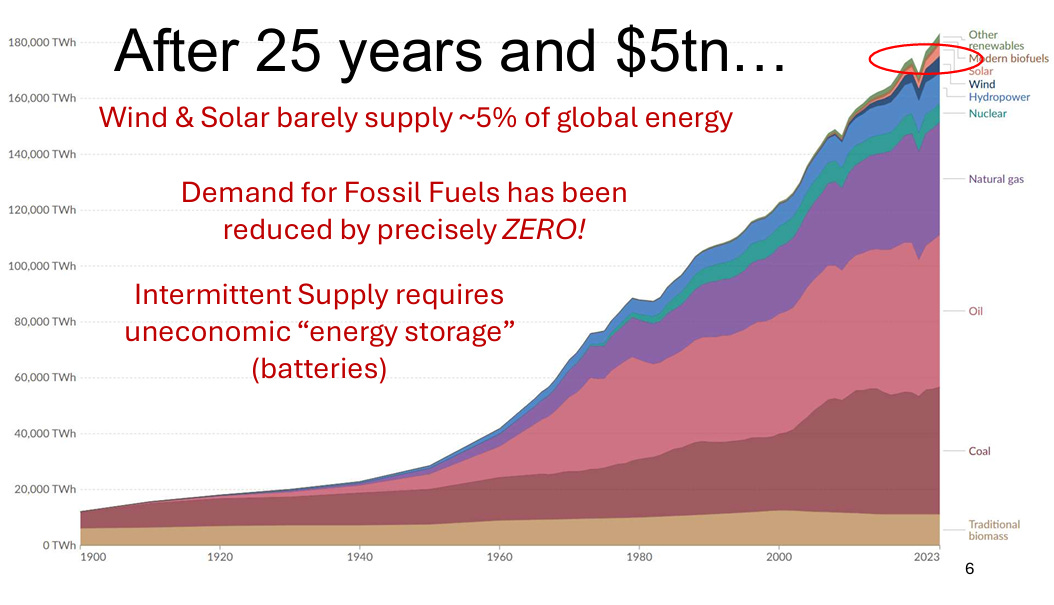Podcast Episode Details
Back to Podcast Episodes
Clean Energy from Nuclear Waste: The Radical Economics of Thorium Reactors
Part I: Why This Series Matters—and What Comes Next
This three-part series with Erik Townsend began with a simple but urgent question:How do we power a prosperous future for everyone—without wrecking the planet in the process?
The stakes are real. Economic growth has always been tethered to rising energy consumption. And as billions of people in the developing world continue their climb out of poverty—and as AI and digital infrastructure drive an explosion in electricity demand in the developed world—the question isn’t whether global energy consumption will rise. It’s by how much, and what kind of energy will meet that demand.
Let’s be clear: energy demand is always met with supply. When clean energy isn’t available, fossil fuels fill the gap.
That’s why, despite trillions invested in wind and solar, fossil fuel use continues to rise. We’re not replacing dirty energy—we’re supplementing it. And unless we fix the constraints that are preventing next-generation nuclear energy from scaling, this pattern will only worsen.
That’s why I wanted to do this series.
The Core Problem—and the Missed Opportunity
We live in a world where technological solutions exist, but political systems prevent their deployment.
Erik Townsend has laid out a compelling blueprint for how we can mass-produce safe, cheap, thorium-fueled molten salt reactors using technologies already proven in the lab. These reactors don’t just reduce emissions—they can slash the cost of energy by orders of magnitude, unlock productivity, and provide clean power to every corner of the planet. That includes regions that still struggle to keep the lights on, let alone power AI data centers.
But right now, Western regulatory regimes are functionally designed to prevent innovation in nuclear energy, not enable it. Meanwhile, China is racing ahead—already demonstrating advanced reactors and signaling a strategy to dominate global energy and technology supply chains by mid-century.
The longer we wait, the greater the cost—not just environmentally, but geopolitically.
Why This Series—and Why Now?
Some readers may notice that this third episode is the most technical of the three. I considered warning you about that upfront. But doing so might have scared people away from what is arguably the most important part of the conversation. This episode is where we move from high-level vision to engineering reality—and where Erik’s credibility as a serious voice in the nuclear debate becomes most obvious.
It’s also timely.
Just days ago, the White House issued a new Executive Order (May 24) outlining a new push for clean energy infrastructure. In theory, this could represent a step toward the kind of policy environment Erik has been calling for. In practice, the jury is still out. I’ll have more to say about that EO and how it aligns—or doesn’t—with Erik’s plan in a follow-up post shortly.
But this essay and episode were designed to do something different: to provide the technical foundation that explains why Erik’s plan isn’t just visionary—it should be achievable., though we won’t know that unless we try.
The Debate Around Erik’s Vision
Erik isn’t presenting a finished doctrine—he’s actively seeking feedback from experts in engineering, policy, and energy economics to refine his proposals. His aim isn’t to win an argument—it’s to build a better plan. So send him commentary!
In fact, there are very few detailed rebuttals to his core thesis to be found. Most people don’t deny that molten salt reactors and mass-manufactured SMRs offer enormous promise. Instead, the pushback tends to fall into these two concerns:
* Can we overcome the regulatory inertia and political headwinds—especially in the West, where nuclear licensing can cost hundreds of millions and take a decade or more?
* Can a relatively unproven technology like thorium be scaled fast enough
Published on 3 months, 2 weeks ago